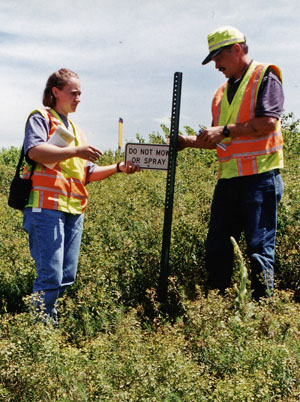By Lisa Yang

Tina Markeson, Roadside Vegetation manager, and Paul Walvatne, Environmental Services (now retired), put up a “Do not mow or spray” sign prior to releasing biocontrol insects along Interstate 94 near U.S. Hwy 52 in St. Paul. Mn/DOT file photo |
Tina Markeson, also known as Bug Lady in some of the districts, encounters many right of way and roadside incidents during her statewide travels as the department’s Roadside Vegetation manager.
Markeson works in the Roadside Vegetation Management Unit, which is part of the Office of Environmental Services located in the Central Office Building. In her current position, Markeson’s duties include controlling noxious weeds on Mn/DOT roadsides, identifying and putting a value on trees and shrubs that need to be removed from right of way and assisting district personnel with vegetation issues.
What is your typical day like?
During the summer, I spend June and July collecting bugs, which we call biological control agents. I use a net to sweep the bugs from plants and grass at specific sites where they have been previously released and reproduced. Then, I put them into a screen that acts like a sorter to separate all the different bugs that I’ve caught. We use these bugs to eat leafy spurge, purple loosestrife and spotted knapweed.
When I’m traveling statewide, I spend time analyzing vegetation on right of way. I identify weeds and if I need to, I release the right kind of bugs to control or get rid of the weeds, but I usually give the bugs to the district personnel to do this. They call me the Bug Lady.
When I’m in the office, I’m usually working on reports, geographical information system technology, and the office’s website.
How often do you travel to sites and what prompts you to go?
I usually go out at least once a week. There are times in the summer when I have to go out every day, but we also have video logs that I can view on my computer if the issue is only about one tree or shrub.
It starts with a call from district personnel in maintenance or permits and sometimes from the public. They either want a plant or tree identified or want it removed. Usually, it’s a business owner or home owner who wants trees removed. It’s 100 percent for visibility to whatever is adjacent. If they want a tree or vegetation removed, I have to put a value on it and help the district determine if the tree or vegetation should be allowed to be removed.
How do you put a value on trees?
It’s based on average bid prices which determines how much it costs for Mn/DOT to put something back into the same location or replace it with something that serves the same function as the vegetation being removed. The person who wants it removed is responsible for removing the tree and has to also pay Mn/DOT. If we don’t plant something back in the same location, we then plant elsewhere in the same district.
What interesting experiences have you encountered in this job?
There’s something that we call midnight cutting. One day, I was called to District 3 to look at some trees. When I got to the site, I saw holes in the ground. It turns out somebody had taken out some trees including the roots. There are also people who have bulldozed trees off our right of way. Sometimes people ask for permission and sometimes they don’t. In Banning, Minn., someone girdled 60 trees. We had some media coverage on it and I had to put a value on those trees.
What projects are you working on right now?
I’m helping with trying to find out how to best utilize the timber that is on Mn/DOT’s property. There is a law which says that we cannot give away state resources, so we end up burning the timber on our land. We’re working with the Department of Natural Resources on this issue.
Do you enjoy what you do?
I enjoy it because I have opportunities to see the state. There are awesome differences between traveling from northwest Minnesota to southeast Minnesota. I also enjoy it because the people in our unit work very well together to figure out the best ways of getting things done for our customers.
Do you or a co-worker have an interesting job to share with readers? Click here to send us your ideas, and we’ll contact you for more information.
Recent employee profiles:
|



